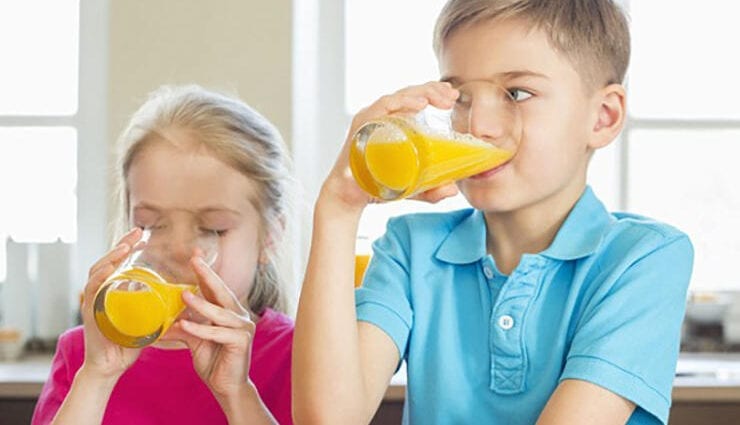
It is difficult to argue with the fact that juices in the diet of children are necessary and useful. But not all juices are equally saturated with vitamins and can be introduced into the child’s menu. At what age and what juices to prefer – read below.
How much and at what time
Fresh juices are not an easy product. Along with the benefits, they provoke an increase in the acidity of the stomach and irritate the mucous membranes. With frequent use, juices can cause allergies or digestive problems. Therefore, the rule – the more, the better – does not work with juices.
Up to a year, the use of juices should be of an introductory nature. After a year, you can drink about 100 grams of juice a day, but not every day. It is necessary to introduce juice into the baby’s diet gradually, starting with a teaspoon and increasing its amount every day exponentially.
An adult child can drink a glass of juice a day. In exceptional cases, two.
Rules for the use of juices
For a child, be sure to dilute the juices with water 1 to 1 to reduce the concentration of acid entering the stomach and intestines.
Prepare the juices yourself to be sure of the quality of the raw materials. Fresh is a medium for the development of bacteria, so when preparing juice, everything should be exceptionally clean, and the juice should be drunk immediately.
If you buy juice in a store, pay attention to the indication of age – for different categories, manufacturers use different dilution and saturation with preservatives.
Carefully study the packaging, check the shelf life and storage, the integrity of the packaging.
Read the composition of the juice and do not buy juices that cause you to be suspicious of the amount of sugar or the content of unknown additives in it.
Apple juice
Most often, apple products – juices and purees-are introduced as one of the first fruit complementary foods. Apple juice can be administered to an infant after 6 months, based on the state of his digestive system.
Apples do not cause allergies, contain iron, potassium, boron, copper, chromium and other useful vitamins and trace elements, as well as enzymes that improve digestion.
Tomato juice
This juice can be given to a child at 8-9 months, adding a small amount to dishes and subjecting it to heat treatment. You can fully introduce tomato juice into the child’s diet after 3 years.
Tomato juice is an antioxidant, has a beneficial effect on blood vessels and is a prevention of cancer. This juice is rich in fiber, so it is useful for stool disorders and digestive problems.
Since tomato juice is an allergenic product, it is not indicated for children at an early age and who have allergic diseases.
Banana juice
Or rather, banana nectar, which contains banana puree, water and sugar. Bananas are also introduced into the baby’s diet after 6 months. Bananas contain a lot of potassium and they are an excellent prevention of constipation and intestinal problems of the child.
Peach and apricot juice
These juices contain beta-carotene and potassium, fiber. They normalize the work of the intestines, since they are not without pulp. Due to the sweetness of the fruits themselves, there is little additional sugar in it. Since these juices can cause allergic reactions, they are not recommended for children under 1 year old.
Grape juice
Sweet juice that is easily prepared at home in the season. It should be borne in mind that due to the content of glucose and fructose in large quantities in grapes, this juice is very high in calories. And despite the fact that it perfectly satisfies hunger, its use should be carefully dosed for children suffering from excess weight. Grape juice is useful, it contains many vitamins and trace elements, but sugar can cause fermentation processes together with dairy products, which are rich in the diet of children. Since sugar destroys tooth enamel, it is recommended for children after 2 years and it is advisable to drink it through a straw.
Pumpkin juice
Pumpkin, like carrots, is rich in carotene and can provoke yellowness of the skin, so you can not often use pumpkin juice. This product contains a lot of potassium, magnesium, B vitamins – it calms and slows down psychoemotional processes. This juice can be administered after 6 months, having previously thermally treated it. Raw pumpkin juice, like banana juice, is presented in the form of pumpkin puree as part of other juices or diluted with water.
Pineapple juice
This fruit is from the category of exotic, and therefore it is not recommended for children under 3 years old. Since the juice is unpopular on the recommendations of nutritionists and pediatricians, it is included in the composition of multifruit juices, and pure is available only for adults. The benefits of pineapple in increasing the level of hemoglobin are undeniable, and anemia is not uncommon among children. Therefore, do not ignore multicomponent juices.
Orange juice
Orange juice is very popular, as it is available both commercially and for home production. Oranges are a source of vitamin C, folic acid and potassium. Orange juice strengthens blood vessels, reduces blood pressure, increases appetite and stimulates intestinal motility. Only here the level of allergenicity in orange juice is very high, and its acid can harm the gastric mucosa of the child. It is better to wait 3 years before introducing this juice to children.










